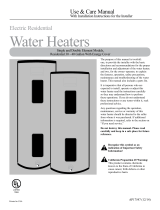1. INSPECT SHIPMENT — Inspect the water heater for possible damage.
Check the markings on the rating plate of the water heater to be certain the
power supply corresponds to that for which the water heater is equipped.
2. THERMAL EXPANSION — Determine if a check valve exists in the
inlet water line. It may have been installed in the cold water line as a
separate back flow preventer, or it may be part of a pressure reducing
valve, water meter or water softener. A check valve located in the cold
water inlet line can cause what is referred to as a ”closed water
system”. A cold water inlet line with no check valve or back flow
prevention device is referred to as an ”open” water system.
As water is heated, it expands in volume and creates an increase
in the pressure within the water system. This action is referred
to as ”thermal expansion”. In an ”open” water system, expanding
water which exceeds the capacity of the water heater flows back
into the city main where the pressure is easily dissipated.
A ”closed water system”, however, prevents the expanding
water from flowing back into the main supply line, and the result
of ”thermal expansion” can create a rapid, and dangerous pres-
sure increase in the water heater and system piping. This rapid
pressure increase can quickly reach the safety setting of the re-
lief valve, causing it to operate during each heating cycle. Ther-
mal expansion, and the resulting rapid, and repeated expansion
and contraction of components in the water heater and piping
system can cause premature failure of the relief valve, and pos-
sibly the heater itself.Replacing the relief valve will not correct
the problem!
The suggested method of controlling thermal expansion is to install
an expansion tank in the cold water line between the water heater and
the check valve. The expansion tank is designed with an air cush-
ion built in that compresses as the system pressure increases,
thereby relieving the over pressure condition and eliminating the re-
peated operation of the relief valve. Other methods of controlling ther-
mal expansion are also available. Contact your installing contractor,
water supplier, or plumbing inspector for additional information re-
garding this subject.
IMPORTANT!! Do not apply heat to the hot or cold water supply fitting. If
sweat connections are used, sweat tubing to adapter before fitting
adapter to cold water inlet of heater. Any heat applied to the hot or cold
water supply fittings will permanently damage them.
3. WATER SUPPLY CONNECTIONS — Refer to Fig. 2 or 3 for suggested
typical installation. The installation of unions or flexible copper connectors
on the water connections is recommended so that the water heater may be
easily disconnected for servicing if necessary. Connect cold water supply
line to 3/4” pipe connection near the bottom of water heater. (Refer to
Figure 2.) Install a shut-off valve and a drain valve (not supplied) in the cold
water line near the water heater (Refer to Fig. 2.). Connect hot water line to
3/4” pipe connection marked HOT on the side near the top of the water
heater. On the some models, the hot and cold water connections are 1/2”
pipe connections and are located on top of the heater. (Refer to Figure 3.)
A drain valve is supplied on these models. Local codes may require an
Anti-Syphon device on the water inlet of a side connect water heater.
3
The location chosen for the water heater must take into consideration the
following:
LOCAL INSTALLATION REGULATIONS
This water heater must be installed in accordance with these instructions, local
codes, utility company requirements or, in the absence of local codes, the latest
edition of the National Electrical Code. It is available from some local libraries or
can be purchased from the National Fire Prevention Association, Batterymarch
Park, Quincy, MA 02269 as booklet ANSI/NFPA 70.
LOCATION
This water heater is designed to meet a wide range of applications. It fulfills a
demand for a small water heater that can be installed in a limited space such as
under counter tops, in cabinets or in a closet. Locate the water heater in a clean
dry area as near as practical to hot water fixtures, or close to the hot water
faucet most frequently used. Place the water heater in such a manner that the
thermostat and element access panels can be removed to permit inspection
and servicing such as removal of elements or checking controls. The water
heater and water lines should be protected from freezing temperatures. Do not
install the water heater in outdoor, unprotected areas.
The water heater should not be located in an area where leakage of the
tank or connections will result in damage to the area adjacent to it or to
lower floors of the structure. Where such areas cannot be avoided, it is
recommended that a suitable catch pan, adequately drained, be installed
under the water heater.
NOTE: Auxiliary catch pan installation MUST conform to local codes.
Catch Pan Kits are available from the distributor or store where the water
heater was purchased
Introduction
A — Diameter of water
heater plus 2" min.
B — Maximum 2"
To open drain, line
should be at least
3
/
4"
ID and pitched for
proper drainage.
A
B
Figure 1. — Auxiliary Catch Pan














